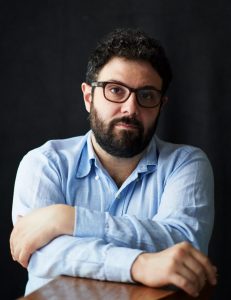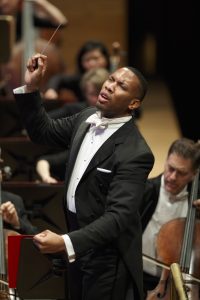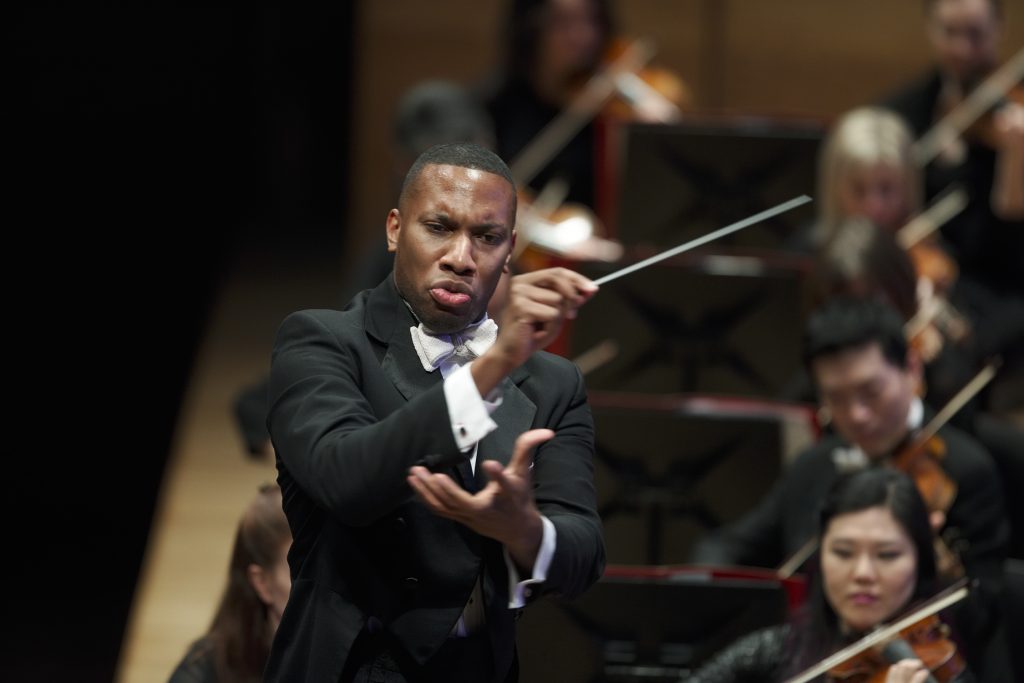COX ROCKS
Sharing a program with organ superstar Cameron Carpenter, a most exciting young conductor graced Disney Hall last weekend with his triumphant debut. Roderick Cox from Macon, Georgia, is one of the very few black conductors world-wide; tall, statuesque, handsome and elegant, the 31-year-old has an air of sophistication swirling about him (aided, no doubt by his gorgeous tux and blindingly shiny, black patent-leather shoes). I wouldn’t have been surprised at all had he pulled out a cane and top hat to tap down a flight of stairs. But he’s also regal and full of finesse — his style at the podium is strong, precise, and commanding.
Cox joined the Minnesota Orchestra in 2015 as an assistant conductor, leading Young People’s concerts and also serving as cover. In 2016 he was promoted to associate conductor, a post he recently left to fulfill his place in the national and international spotlight, guest conducting at major orchestras.
In turn, an upsurge of younger organists have also bagged attention: for glam appeal, there is Carpenter, who in the past has played flamboyantly in even-more flamboyant outfits. Those expecting a circuit-boy-Liberace got a relatively conservative guy who could easily have played in a church, wearing as he was a simple black-velvet tux coat, and sporting a buzz cut instead of his trademark Pompadour hairdo. Nor did he have with him his own custom designed electronic organ — an Opus 8 by Marshall & Ogletree — with which he often travels. Given the status of Hurricane Mama, Disney Hall’s ten-octave pipe organ, as one of the world’s greatest instruments, that decision surely was a no-brainer.
 As for the world premiere commissioned by the LA Phil from composer Chris Cerrone that opened the program: I wouldn’t be at all saddened should the 34-year-old leave the world of concert halls and head straight for a career as film composer. This is the fifth premiere of his I’ve witnessed, and — except for his mini-opera Invisible Cities — they all have striking similarities. Diverting to watch live, it all feels like a grand musical experiment that hasn’t arrived somewhere new.
As for the world premiere commissioned by the LA Phil from composer Chris Cerrone that opened the program: I wouldn’t be at all saddened should the 34-year-old leave the world of concert halls and head straight for a career as film composer. This is the fifth premiere of his I’ve witnessed, and — except for his mini-opera Invisible Cities — they all have striking similarities. Diverting to watch live, it all feels like a grand musical experiment that hasn’t arrived somewhere new.
Here, The Insects Become Magnetic sure lived up to its title. With ginormous beds of speakers dangling over the stage, Mr. Cerrone sat among some 90 players “performing” on an iMac stage left. He certainly has perfected that science-fiction soundscape: That haunting, mysterious, dreamy, spooky, surreal, melody-free, mini-phantasmagoria that surges with ever-crescendoing brass and electronic pulses, and then ebbs with a diminuendo passage, then surges and ebbs again and again in waves of tremolos and shimmers until the clever orchestrations quietly die away like eerie breathing. The way he mimicks sounds of life — a cricket chirping, a phone ringing, perhaps — fascinates, especially in his use of xylophones and celesta. As the otherworldly sonorities both calm and restless washed over the hall, it didn’t resonate for me — the 15-minute work desperately needed a story and 70mm projections.
For his first piece last Sunday afternoon, Poulenc’s Concerto for Organ, Timpani, and Strings, Carpenter sat at the portable console — which came down to the lip of the stage — with his back to the audience. In the second half, made up entirely of Saint-Saens’ Symphony No. 3, the console was upstage left next to the piano, so we got all sides of the 37-year-old, musically and physically. (Rarely  have I seen someone play directly under the French Fries-shaped organ.) Carpenter has been performing these two pieces together for years, so I was surprised he had music for the “Organ” Symphony.
have I seen someone play directly under the French Fries-shaped organ.) Carpenter has been performing these two pieces together for years, so I was surprised he had music for the “Organ” Symphony.
Cox captured every nuance of Poulenc’s string and timpani writing with startling clarity. His intense focus on LA Phil’s remarkably taut and gorgeous string section, combined with Carpenter’s voluminous acoustics, highlighted a remarkable sense of the interior detail surrounded by that deep, rich organ sonority — the thunderous Gothic G-minor chord that begins the piece filled the very full hall with a gooseflesh-inducing flourish of sound. It’s a show-off piece because each of the sections of the 20-minute work offers a different style and tone, which is exciting enough, but this was thrilling. Indeed, this was one of the best integrated and most transparent versions of the piece I’ve heard; I also heard notes from the organ that I never knew were there. Watching the blowing, bellowing majesty of that behemoth’s wood shutters swinging open and shut to amplify sound was an awesome experience.
It was during his encore, however, that we really got to see Carpenter’s ferocious foot maneuvers, flickering fingerwork, and quick-draw changing of manuals. Everything was big for Bach’s Little Fugue in G minor. What I was most taken with was the Julliard-trained keyboardist’s astonishing technical proficiency, playing two keyboards with one hand at one point!
 A favorite work for many, Saint-Saens’ Third is indeed a remarkable symphony — one of the most technically advanced and sophisticated of the late 19th century, packed with innovations for the time, and without doubt the pinnacle of his achievements. He does away with the old structures and produces a work of two halves, introducing the piano along with the organ, it’s a shame that the ingenious addition of four-handed piano alongside the orchestra is short-lived.
A favorite work for many, Saint-Saens’ Third is indeed a remarkable symphony — one of the most technically advanced and sophisticated of the late 19th century, packed with innovations for the time, and without doubt the pinnacle of his achievements. He does away with the old structures and produces a work of two halves, introducing the piano along with the organ, it’s a shame that the ingenious addition of four-handed piano alongside the orchestra is short-lived.
Carpenter’s introduction was especially subtle, and beautifully crafted. The very familiar theme — based on the old Latin plainchant Dies Irae — was revealed with terrific resolve by Cox, who conducted from memory. The theme hit us in both major and minor keys throughout the symphony, rendered at first extraordinarily tender by the conductor, until fully and thrillingly performed by the fiery, awesome Carpenter in the closing finale. Given that the actual part for his instrument is quite simple, Carpenter wisely kept any histrionics at bay; he remained relegated to those deep pedal points and sustained chords that underpin the orchestral activity (Whitney Crockett on bassoon and Burt Hara and Boris Allakhverdyan on clarinets did stupendous work). The colossal event was greeted with deservedly roaring accolades from the crowd. Welcome to the limelight, Maestro Cox.
previous concert photos of Roderick Cox by Greg Helgeson
Cameron Carpenter photo by Michael Hart
Los Angeles Philharmonic
Roderick Cox, guest conductor
Cameron Carpenter, organ
Walt Disney Concert Hall
played November 16-18, 2018
for future events, call 323.850.2000 or visit LA Phil



{ 1 comment… read it below or add one }
Absolutely spectacular new conductor on the scene. What a musical pleasure to see the results.